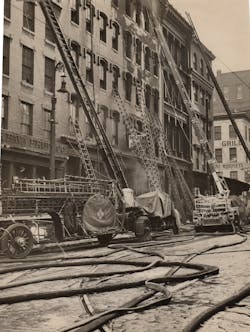Rekindles 11/11
LONDON, ONTARIO: NOV. 3, 1911 – A serious fire threatened this city’s business section and proved difficult to control. Workers discovered an advanced fire when they opened the Chapman & Co. store. The place was described as a seething furnace and the fire department was immediately summoned. Upon the arrival of the first units, flames were blowtorching across the street and igniting exposed buildings. In short order, firemen had 15 hoselines in operation and struggled as fire leaped from building to building. Firemen were in constant danger as they worked near fire-weakened walls. Several large business properties were destroyed, leaving more than 500 people without jobs.
BROOKLYN, NY: NOV. 3, 1911 – An oil stove ignited a wooden partition inside 62 Water St., the four-story home of the Veneer Barrel Co. With flames pouring from the top-floor windows, hoselines were stretched and an aggressive attack was begun. On the roof, companies operated to expose fire in the cockloft. They included members of Engine 107 (now Engine 207), who were manning a charged line. Suddenly, the roof began swaying and Captain James A. Hagan ordered his men, “Back to the ladder!” During the evacuation in a dense smoke condition, the captain tripped on the cornice of a skylight and plunged headfirst into the shaft below. The 10-year veteran was killed instantly and left behind a wife and small child.
McKEESPORT, PA: NOV. 3, 1911 – In March 1911, Anna Rosen was rescued from the deadly fire in the Triangle Shirtwaist Factory in New York City. The “factory girl” moved from that city and settled back into the family home on Mulberry Street. While she slept, a gas line was leaking within the house and the gas explosively ignited when Anna’s sister entered the room and struck a match. Young Anna was critically burned and died several hours later. Her sister was also seriously burned, but would recover.
BOSTON, MA: NOV. 4, 1911 – A young woman named Maud Gesner was awakened by the smell of smoke and calmly evacuated the other 20 young women in the Boston Students Union Clubhouse on Saint Stephen Street. The women assembled in the reception room, gathered around the piano and began singing songs as the firemen moved in and extinguished a fire burning in the clubhouse’s kitchen.
GLENS FALLS, NY: NOV. 5, 1911 – The roof of the Lake George summer home of the Peabody family was being repaired by tinsmiths when one of their torches touched off a fire. Flames began spreading quickly as about 200 residents formed a bucket brigade from the lake to the burning home. Sadly, their efforts were in vain as the large home burned to the ground.
BAYONNE, NJ: NOV. 6, 1911 – City residents were shocked when a huge explosion rocked their homes. Leaving their homes, they saw a tremendous column of flames swirling above the storage tanks in the nearby Standard Oil Yards. Several tanks were ablaze as the oil yard fire brigade moved in and went to work. An explosion seriously injured a number of oil yard employees as they attempted to control the fire. Conditions became so severe the city fire department was requested. With the additional manpower on hand, efforts to protect the other tanks began to pay off. Two hours after the first blast, the fire began to darken down.
BOSTON, MA: NOV. 9, 1911 – A gasoline explosion ignited a fire that trapped a 65-year-old woman and her granddaughter on the roof of the blazing five-story brick building. The explosion occurred in a first-floor tailor shop and sent flames racing through the building. A pair of unlikely rescuers sprang into action. Fannie Boylan saw the people trapped above and made her way toward them. From a separate vantage point, Bernard “Poco” Bennett also hurried toward the roof. Bennett was known to generations of Harvard students as “a college men’s broker” (a moneylender). Mrs. Boylan took the baby in hand and “Poco” helped the old woman to safety just as the first fire trucks pulled up.
DETROIT, MI: NOV. 15, 1911 – An early-evening blaze on Jefferson Avenue threatened to spread to the entire block as firemen had to work in blizzard conditions. The fire started on the fourth-floor of the Fisher, Garton & Wills wholesale millinery company building. For two hours, firemen battled the flames and the wind-driven snow to hold the fire and save the adjoining buildings.
PITTSBURGH, PA: NOV. 21, 1911 – Just as the first act at the Palm Garden Theatre came to a close, an “irresponsible person” shouted “Fire!” Instantly, there was a great panic among the 300 people in attendance. Men threw aside women and children in their efforts to escape. The manager opened all the exits and took the stage attempting to quiet the throng with little success. Firemen arrived to find not fire, but rather a half-dozen children trampled by the frenzied mob. The children were taken to St. Joseph’s Hospital.
LIVERPOOL, ENGLAND: NOV. 24, 1911 – A dust explosion in the Bibby & Sons oil cake mills killed 39 men and seriously injured and maimed 101 other workers. The initial blast was so violent it blew the roof off and showered the streets around the building with flaming debris and human remains. Some walls collapsed and the remaining sections of the mill were soon in flames. Hundreds of workers crowded into the streets, covered with yellow oil cake and dust and their hands and faces smeared with blood. The fire brigade arrived quickly and rescued many still trapped in the building, tended to the injured outside and battled the raging flames.
